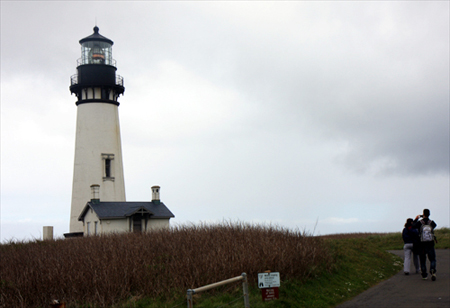
While other lighthouses on the Oregon Coast feature small museums about the history of the area, the Yaquina Head Lighthouse offers a significantly sized interpretive center and natural area which shouldn’t be missed.
What also makes Yaquina Head different, is there are really three attractions in one location. Your first stop should be the interpretive center, where you will find a nice, large building that is filled with information about this U.S. Department of Interior park.
From park rangers on hand to answer questions about not only the lighthouse, but nature area and attractions around Newport, these experts can give you unique insights into the history, and current use of the lighthouse.
The bulk of the building, however, is filled with displays with information that explains everything from the trials and tribulations of being a lighthouse keeper, to how the lighthouse was built, to even how lighthouses work and how far their light shines. There are also displays about the history of the area, how Yaquina Head was discovered and the wildlife you can see in the area.
Gray whale bones are one display, as well as the many different types of sea birds in the area below the lighthouse and on the rocks around the headlands.
The center also includes a gift shop that helps support the Friends of the Yaquina Lighthouses (there is another lighthouse at Yaquina Bay). The volunteer organization helps in the restoration and preservation of the two lighthouses that are around Newport. The gift shop offers coats, hats, books, stuffed animals and other tourist items.
While the interpretive center is a good learning experience, where the real attraction lies is outside.
The lighthouse, which is up the access road from the interpretive center, sits on a headlands – a rock outcropping surrounded by the Pacific Ocean on three sides. There are walking trails around the tallest lighthouse on the Oregon Coast where you can look down at the beach and ocean. Trails run from around the lighthouse to above the site on Salal Hill, there are also trails down to the tidepools.
The day I visited there was a pretty good storm rolling in, and if you like waves crashing over rocks and storm watching, this is an excellent site to take full advantage of the power of nature. Storm watching is fun out in the rain, but you can also do it from the car, if that is more your speed.
Tours of the lighthouse are offered, and you can climb the stairs and even see the lens of this historic lighthouse that has been in operation since 1872. Fun fact, it took more than 370,000 bricks and one year to construct the lighthouse.
But if looking at a lighthouse doesn’t interest you, and you enjoyed the view, but it didn’t take much time for you to experience it, the tide pools below Yaquina Head are filled with discovery.
By taking another access road on your way out of the park, you can walk down to the beach and see tide pools that are teaming with sea stars, anemones and urchins. The day I visited the park, it was stormy, as I mentioned, so I didn’t get too close to the churning waters. But during calm days, when the tide is out, visitors can walk along the rocks and do some exploring. There are educational opportunities all over the small beach, but BLM officials warn visitors to make sure people done harm the ecosystem and watch their step, as it is slippery.
About the Yaquina Head Outstanding Natural Area: Yaquina Head Outstanding Natural Area is located on a narrow point of land jutting due west into the Pacific Ocean at the north end of Newport, Oregon. This headland provides visitors with one of the most accessible wildlife and ocean viewing locations on the Pacific Coast.
What to bring: Weather-appropriate clothing is very important whenever you visit the Oregon Coast, but when walking around a headlands, it becomes even more important. Good shoes are also important if you are going to be walking on the trails or visiting the tide pools to explore. Make sure they have good traction, as the rocks around the tide pools can be very slippery.
Tip: One of the things to keep in mind is that the lighthouse and interpretive center have different hours of operation. The lighthouse opens later than the interpretive center, so if you get an early start of your day, expect to spend at least an hour in the center before heading up to the lighthouse. Also, there is a fee for entering the park, so make sure you visit the BLM website listed above to find out the most recent fee schedule.
Season: The lighthouse and center is open year round.
Getting there: Plug 750 NW Lighthouse Dr, Newport, Oregon into the navigation system and it is pretty easy to find right off Highway 101 north of Newport. Those using maps to get from point A to point B should know that Lighthouse Drive has an intersection with Highway 101 north of Newport, and there are ample signs to point you in the right direction.
By Patrick Johnson
For Oregon.com